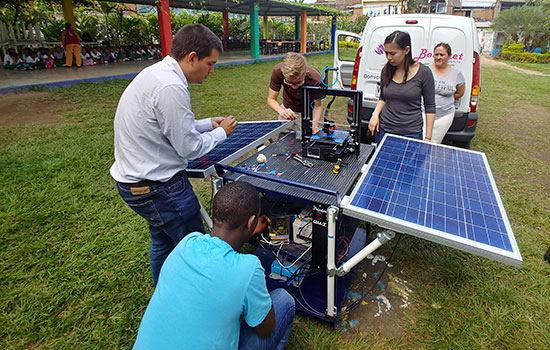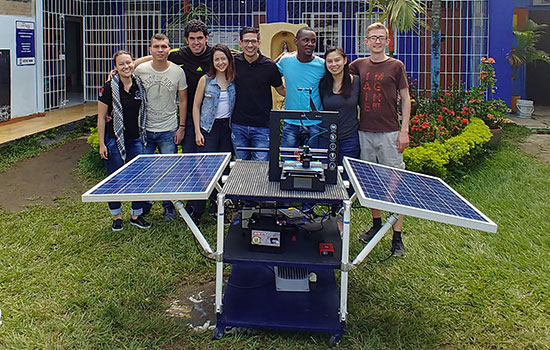Last week, engineering students and faculty from the Rochester Institute of Technology (RIT) New York, traveled to Cali, Colombia to hand over their newly developed solar-powered 3D printing system.
The team worked with students and faculty from the Universidad Autónoma de Occidente (UAO) to create a 3D printer powered by a unit harnessing multiple energy sources within developing areas. Both universities hope that this project can help at-risk youths in Cali develop valuable skills in additive manufacturing.

Reliable 3D printing technology
This project is part of the Multidisciplinary Senior Design (MSD) program, a two-semester senior course that integrates engineering theory and practices within a collaborative environment.
Six RIT electrical, industrial and mechanical engineering students along with the UAO team conceptualized the idea for a 3D printing system that could remain fully operational at all times.
“The goal is to implement this printing system in Colombia because their electricity isn’t that reliable and because 3D printers need a constant flow of electricity to function,” said Joshua Cohen, a fifth-year RIT engineering student, who worked on the project.
“Having those backup power sources like the solar panels or the battery or also being able to plug into the grid are all things that will keep this printer up and running in the community.”
The UAO team also took on the task of recycling plastic bottles as reinforcement for 3D printer filament.

An academic agreement
This project is the first successful step in an agreement made by RIT and UAO several months ago. The agreement intends to develop student and faculty research relations focused on international product design theory and commercialization for developing economies. Both universities share a common objective to broaden regional economies through international collaboration from students.
The project was led by RIT Associate Professor, Marcos Esterman, and his former student Alvaro Rojas Arciniegas.
3D printing in developing countries
3D printing has served multiple areas within developing countries. Sandia National Laboratories designed a set of solar power receivers from 3D printing to use in Indian villages as a cost-effective, non-polluting power source.
U.S non-profit, Field Ready, 3D printed medical supplies in remote regions of Nepal to aid earthquake victims.
3D printing using recycled plastic has also benefited developing countries such as the Solomon Islands, where members of an Australian university used wasted plastic to 3D print parts of water pipes.
Following the success of RIT’s solar-powered 3D printing system, Esterman hopes to expand the partnership with UAO into a series of academic programs that will allow students from both universities to gain design and development experience.
For all the latest stories on 3D printing innovations subscribe to the 3D Printing Industry newsletter, follow us on Twitter and like us on Facebook.
Looking to advance your career in additive manufacturing? Sign up to 3D Printing Jobs here.
Featured image shows RIT and the Universidad Autónoma de Occidente team set up their solar-powered 3D printer in Colombia. Photo via RIT.

